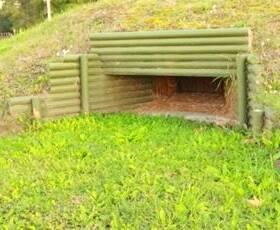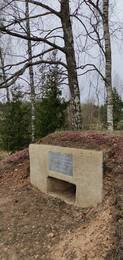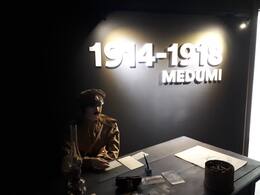Rąstų dėžutė
I WW1, II Antrasis pasaulinis karas, IV Sovietų okupacija
Rąstų bokštas (latv. dzots, kilęs iš rusiško termino „Дзот“ Деревоземляная огневая точка akronimo) yra lauko įtvirtinimų statinys, pastatytas iš rąstų ir lentų su žemių pylimu.
Tabletės dėžei reikėjo daugiau statybos išteklių nei rąstinei dėžei.
Terminas „rąstų dėžė“ kartais buvo vartojamas kalbant apie slėptuvę, panardintą į žemę tranšėjų sistemoje (taip pat bunkeryje arba blindage).
Daugiau informacijos šaltinių
https://encyclopedia2.thefreedictionary.com/Log+Pillbox
Susijusi laiko juosta
Susijusios vietos
Kunderos piliulės dėžutė
Žuvusio Raudonosios armijos 8-ojo Estijos šaulių korpuso karininko Jakobo Kunderos (ištrinta) memorialas yra kapinėse, 200 metrų į pietvakarius nuo Blidenės-Remtės kelio ir Rygos-Liepojos geležinkelio mazgo.
1945 m. kovo 17 d. prasidėjo paskutinis Raudonosios armijos puolimo bandymas Kuržemėje. Estijos 8-ojo šaulių korpuso 7-osios Estijos šaulių divizijos užduotis buvo pasiekti Rygos-Liepojos geležinkelio liniją į vakarus nuo Blidenės stoties ir užtikrinti 3-iojo gvardijos mechanizuotojo korpuso ataką Gaikų kryptimi. Iki kovo 17 d. vakaro 354-asis šaulių pulkas per mišką pasiekė geležinkelį į pietus nuo Kaulačių dvaro ir tęsė atakas šiaurės vakarų kryptimi. Kadangi 130-ojo Latvijos šaulių korpuso atakos Pilsblidenės dvaro link nebuvo tokios sėkmingos, Estijos 300-ajam šaulių pulkui buvo pavesta kovo 18 d. naktį pulti į vakarus ir pietvakarius, kirsti geležinkelį iš šiaurės ir užimti Blidenės stotį.
Blīdenės stoties apylinkėse jau 1940 m. pavasarį Latvijos armija buvo pastatijusi laikinas kareivines ir sandėlius, kurie buvo pavadinti „kareivinėmis“. 1945 m. Vokietijos armija stoties apylinkėse pastatė keletą požeminių slėptuvių (bunkerių), kuriose žiemą galėjo gyventi kareiviai. Nebuvo jokių įtvirtinimų, nei išmuštų, nei duotų, ir labiausiai tikėtina, kad leitenantas Jakobas Kunderis žuvo artimos kovos metu viename iš bunkerių.
Iškart po mūšio Jakobas Kunderis buvo palaidotas dabartinėse Pilsblidenės kapinėse, o vėliau perlaidotas Tuškų brolių kapinėse.
Šiandien galima pamatyti simbolinę sovietinę gelžbetoninės kulkosvaidžio ambrazūros reprodukciją su atminimo lenta.
Pirmojo pasaulinio karo muziejus
Aršiausi Pirmojo pasaulinio karo mūšiai Latvijos teritorijoje vyko netoli Daugpilio – 1915 m. rugpjūtį ir spalį Ilūkstės ir Medumų aukštumose. Vokiečiai bandė prasiveržti į Daugpilį, tačiau rusai juos nustūmė atgal. Nė viena pusė neįgijo pranašumo, todėl abi pusės ėmė kasti apkasus ir suformavo trijų linijų ešelonuotos gynybos padėtis. Abiem pusėms nesisekė, todėl jos ėmė statyti tranšėjas, kurdamos nuodugnios gynybos pozicijas, sudarytas iš trijų linijų.
Pirmojo pasaulinio karo muziejus Medumuose skirtas šiems mūšiams atminti. Pirmoji ekspozicijos dalis supažindina su Medumų krašto istorija ir rodo, kad prieš karą tai buvo gausiai gyvenama ir išvystyta vietovė. Antroji dalis pasakoja apie Pirmojo pasaulinio karo įvykius Europoje ir Latvijoje, pristato karių gyvenimo sąlygas bei karo metu atsiradusias naujoves, taip pat eksponuojami vokiečių ir rusų kariuomenių naudoti ginklai. Trečiojoje ekspozicijos salėje lankytojai gali įsijausti į kareivio gyvenimą – čia atkurta rusų bunkerio kopija su apkasų fragmentu, nedidele slėptuve, karo lauko atributais ir kareivių manekenais. Kadangi mediniai rusų kariuomenės bunkeriai iki šių laikų neišliko, jie rekonstruoti muziejaus ekspozicijoje, o betoninius vokiečių kariuomenės bunkerius galima pamatyti keliaujant tarptautiniu maršrutu, vedančiu per Pirmojo pasaulinio karo vietas. Bunkerio imitacijos salėje naudojama garso ir vaizdo įranga sukuria autentišką karo lauko atmosferą.









